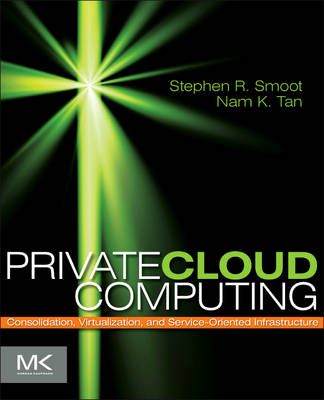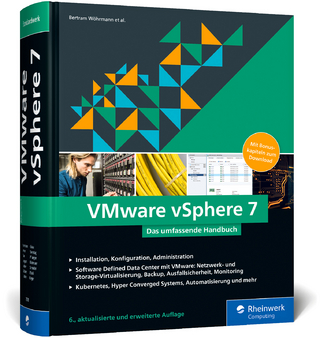
Private Cloud Computing
Morgan Kaufmann Publishers In (Verlag)
978-0-12-384919-9 (ISBN)
Private cloud computing enables you to consolidate diverse enterprise systems into one that is cloud-based and can be accessed by end-users seamlessly, regardless of their location or changes in overall demand. Expert authors Steve Smoot and Nam K. Tan distill their years of networking experience to describe how to build enterprise networks to create a private cloud. With their techniques you'll create cost-saving designs and increase the flexibility of your enterprise, while maintaining the security and control of an internal network. Private Cloud Computing offers a complete cloud architecture for enterprise networking by synthesizing WAN optimization, next-generation data centers, and virtualization in a network-friendly way, tying them together into a complete solution that can be progressively migrated to as time and resources permit.
Stephen R. Smoot, Ph.D., helped start up Riverbed Technology in February 2003, and currently serves as senior vice president of technical operations, running the technical support, technical publications, technical marketing, and global consulting engineering groups. He spends his time thinking about where technology is going and helping customers to solve their problems. Smoot previously worked on acceleration and video at Inktomi Corporation (now a part of Yahoo). He joined Inktomi, following its acquisition of FastForward Networks, which designed overlay network technology for streaming video with millions of viewers over the Internet. Smoot previously worked at Imedia (Motorola), Honeywell, and IBM. Smoot received his doctorate in computer science from the University of California at Berkeley, working with Lawrence Rowe. His dissertation, “Maximizing Perceived Quality at Given Bit-Rates in MPEG Encoding, describes various aspects of creating MPEG video from its original video source. He also holds a master’s degree in computer science from the University of California, Berkeley. His undergraduate education was at MIT where he received bachelor’s degrees in computer science and mathematics. Nam-Kee Tan, CCIE #4307, has been in the networking industry for more than 16 years. He is dual CCIE in routing and switching and service provider and has been an active CCIE for more than 10 years. His areas of specialization include advanced IP services, network management solutions, MPLS applications, L2/L3 VPN implementations, next-generation data center technologies, and storage networking. Nam-Kee is currently the lead network architect in the Riverbed advanced network engineering team where he designs and deploys cloud computing service infrastructures and virtual data center solutions for Riverbed enterprise and service provider customers. Nam-Kee also advises internal Riverbed engineers in the area of next-generation service provider technologies. Nam-Kee is the author of Configuring Cisco Routers for Bridging, DLSwþ, and Desktop Protocols (1999, ISBN 0071354573); Building VPNs with IPSec and MPLS (2003, ISBN 0071409319), and MPLS for Metropolitan Area Networks (2004, ISBN 084932212X); and is co-author of Building Scalable Cisco Networks (co-author, 2000, ISBN: 0072124776). He holds a master’s degree in data communications from the University of Essex, UK, and an MBA from the University of Adelaide, Australia.
Chapter 1 – Next-Generation IT Trends
Layers of Function: The Service-Oriented Infrastructure Framework
Blocks of Function: The Cloud Modules
Cloud Computing Characteristics
Computing Taxonomy
Chapter 2 – Next-Generation Data Center Architectures and Technologies
The Data Center Consolidation and Virtualization Modus Operandi
Server Consolidation Drivers
Server Virtualization
Storage Virtualization
Layer 2 Evolutions
Unified Data Center Fabric
Chapter 3 – Next-Generation WAN and Service Integration
Service Integration in the Data Center
Infrastructure Segmentation
The Next-Generation Enterprise WAN
Chapter 4 – Branch Consolidation and WAN Optimization
What is the WAN performance challenge?
WAN Optimization Benefits
Requirements for WAN Optimization Deployment
Remote Office Virtualization Designs
Chapter 5 – Session Interception Design and Deployment
Selecting an Interception Mechanism
The WCCP Dive
In-path Deployment In-Brief
PBR Deployment Overview
Chapter 6 – WAN Optimization in the Private Cloud
WAN Optimization Requirements in the Cloud
Interception at the VM Level
Cloud Interception with VRF-Aware WCCP
Cloud Interception with Non VRF-Aware WCCP
Interception at the Services Aggregation Layer
Chapter 7 – SAN Extensions and IP Storage
SAN Extension Overview
Optical Networking Solutions
SONET/SDH Services
FCIP
iSCSI
Putting It All Together
Chapter 8 – Cloud Infrastructure as a Service
Cloud Security
Unified Computing System
Cloud Management
Cloud IaaS: The Big Picture
Chapter 9 – Case Studies
Virtual Access-Layer Design Study
ERSPAN Design Study
Unified Fabric Design Study
Top-of-Rack Architecture Design Study
Basic vPC Design Study
SAN Extension Design Study
Service-Oriented Infrastructure Design Study
| Erscheint lt. Verlag | 22.11.2011 |
|---|---|
| Verlagsort | San Francisco |
| Sprache | englisch |
| Maße | 191 x 235 mm |
| Gewicht | 860 g |
| Themenwelt | Informatik ► Betriebssysteme / Server ► Virtualisierung |
| Mathematik / Informatik ► Informatik ► Netzwerke | |
| ISBN-10 | 0-12-384919-5 / 0123849195 |
| ISBN-13 | 978-0-12-384919-9 / 9780123849199 |
| Zustand | Neuware |
| Informationen gemäß Produktsicherheitsverordnung (GPSR) | |
| Haben Sie eine Frage zum Produkt? |
aus dem Bereich


